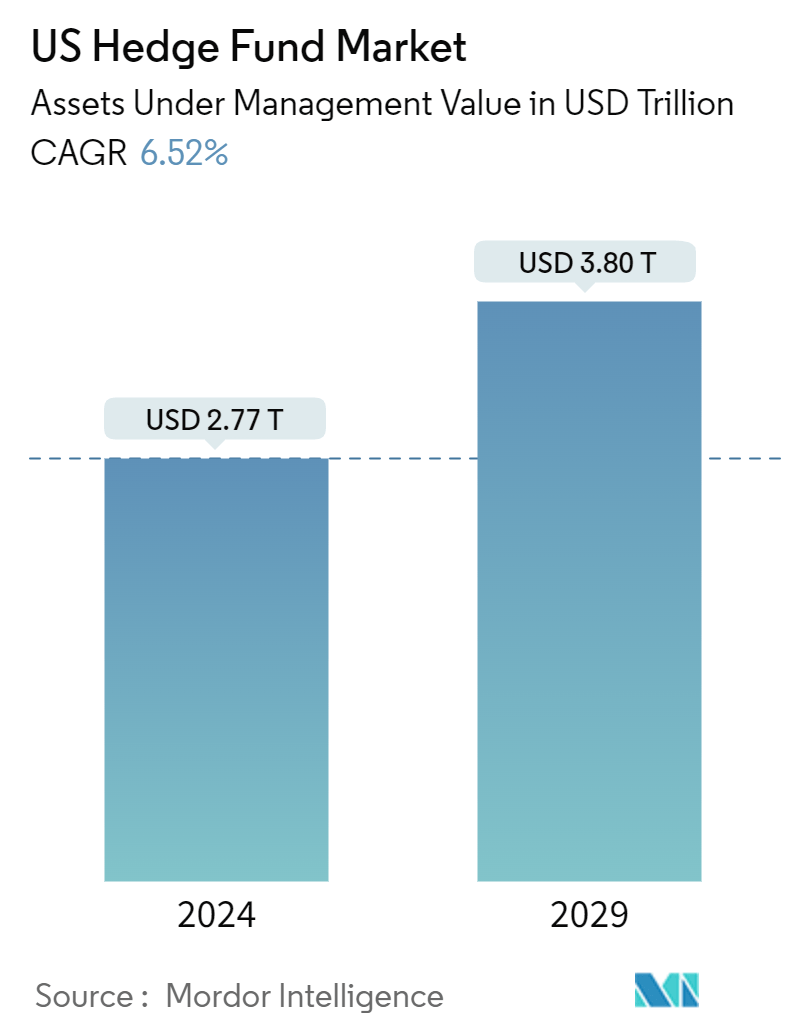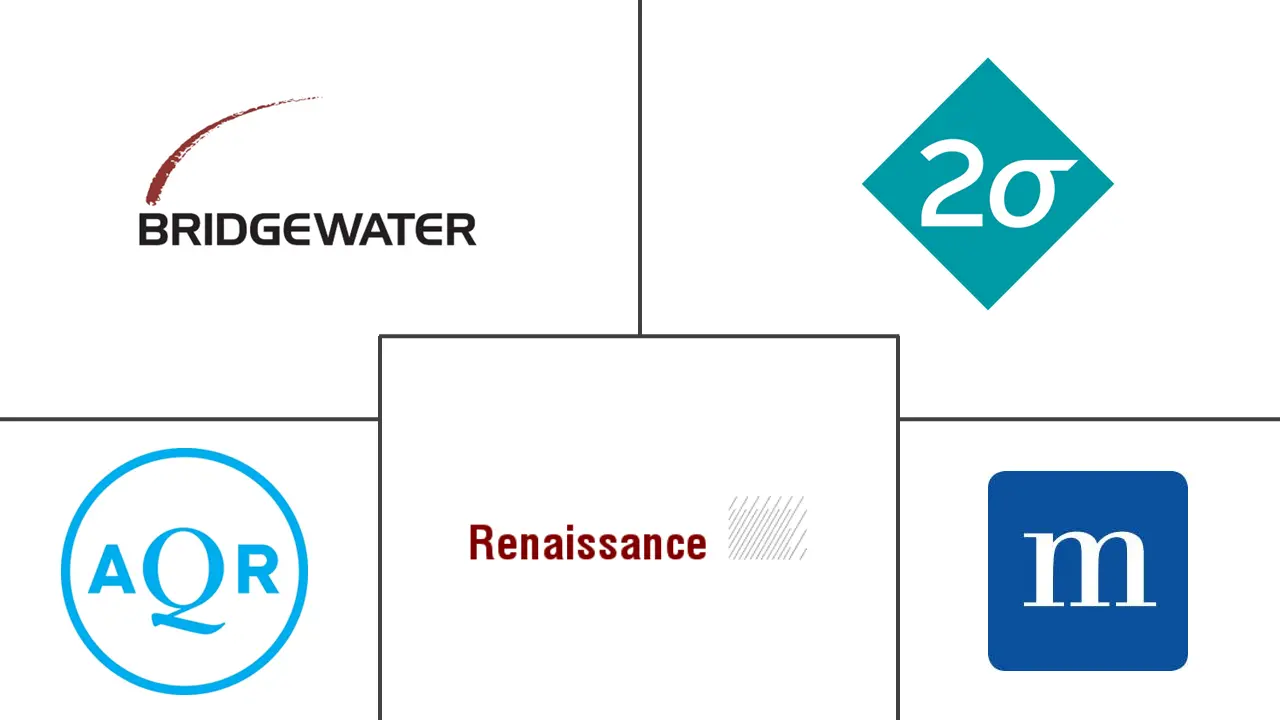Market Size of US Hedge Fund Industry

| Study Period | 2020-2029 |
| Base Year For Estimation | 2023 |
| Market Size (2024) | USD 2.77 Trillion |
| Market Size (2029) | USD 3.80 Trillion |
| CAGR (2024 - 2029) | 6.52 % |
| Market Concentration | Medium |
Major Players
*Disclaimer: Major Players sorted in no particular order |
US Hedge Fund Market Analysis
The US Hedge Fund Market size in terms of assets under management value is expected to grow from USD 2.77 trillion in 2024 to USD 3.80 trillion by 2029, at a CAGR of 6.52% during the forecast period (2024-2029).
The United States hedge fund market is one of the largest and most influential in the world. A hedge fund is a collective investment fund invested in securities or another type of investment to get returns. Hedge funds can use complex trading, portfolio construction, and risk management techniques to improve returns. The United States accounts for three-quarters of this industry's assets under management (AuM) worldwide.
Fund managers also use AIML (artificial intelligence and machine learning) more to increase returns and improve the efficiency of their operations. Several people with strong investment backgrounds are drawn to joining "plug and play" operations because they can concentrate on producing alpha instead of managing the risk and expense of starting their hedge fund, especially with the barriers to entry at an all-time high due to evolving regulatory requirements and complex operational requirements.
US Hedge Fund Industry Segmentation
Investment funds pooled and traded reasonably liquid assets are known as hedge funds. They can employ a variety of sophisticated trading, portfolio creation, and risk management strategies, including leverage, derivatives, and short selling, to increase returns. The market's background is thoroughly examined, covering industry trends, growth factors, market shares, market size and forecast, and suppliers. The research also includes qualitative and quantitative evaluations based on an analysis of data collected from market participants and industry analysts at significant stages in the industry's value chain. The United States hedge fund market is segmented based on core investment strategies, which include equity, macro, event-driven, credit, relative value, niche, and multi-strategy, as well as managed futures/CTA strategies. The report offers market sizes and forecasts for the hedge fund market in the United States in terms of revenue (USD) for all the above segments.
| By Core Investment Strategies | |
| Equity Strategies | |
| Macro Strategies | |
| Event Driven Strategies | |
| Credit Strategies | |
| Relative Value Strategies | |
| Niche Strategies | |
| Multi-Strategy | |
| Managed Futures/CTA Strategies |
US Hedge Fund Market Size Summary
The US hedge fund market stands as a pivotal segment within the global financial landscape, characterized by its substantial assets under management and influential presence. As a collective investment vehicle, hedge funds employ sophisticated strategies involving complex trading, portfolio construction, and risk management techniques to optimize returns. The market's dominance is underscored by the United States holding a significant portion of the world's hedge fund assets. The integration of artificial intelligence and machine learning has become increasingly prevalent, enhancing operational efficiency and return potential. This technological advancement, coupled with the high barriers to entry due to regulatory and operational complexities, has led to a trend where seasoned investment professionals prefer "plug and play" operations, allowing them to focus on generating alpha.
The evolving interest in digital assets and cryptocurrencies has opened new avenues for hedge fund investments, driven by the potential for high returns and diversification. The acceptance of digital assets by mainstream financial institutions has further fueled this interest, prompting hedge funds to develop the necessary technology and infrastructure for managing these assets. This shift has created new business opportunities and revenue streams, with hedge funds actively engaging in the development of trading platforms and custody solutions. The US hedge fund market, moderately fragmented, presents growth opportunities that are expected to intensify competition. Prominent players such as Bridgewater Associates, Renaissance Technologies LLC, and AQR Capital Management continue to shape the market, while strategic partnerships and notable milestones, like the launch of significant hedge funds by women, highlight the dynamic nature of the industry.
US Hedge Fund Market Size - Table of Contents
-
1. MARKET INSIGHTS AND DYNAMICS
-
1.1 Market Overview
-
1.2 Market Drivers
-
1.2.1 Positive Trends in Equity Market is Driving the Market
-
-
1.3 Market Restraints
-
1.3.1 Market Volatility can Impact Fund Performance
-
1.3.2 Regulatory Constraints and Compliance Requirements can Pose Challenges for Hedge Funds
-
-
1.4 Market Opportunities
-
1.4.1 Growing Demand for Sustainable and Impact Investing
-
1.4.2 Advancements in Technology and Data Analytics Present Opportunities for Hedge Funds
-
-
1.5 Porter's Five Forces Analysis
-
1.5.1 Bargaining Power of Buyers/Consumers
-
1.5.2 Bargaining Power of Suppliers
-
1.5.3 Threat of New Entrants
-
1.5.4 Threat of Substitute Products
-
1.5.5 Intensity of Competitive Rivalry
-
-
1.6 Insights on Technological Innovations in the Market
-
1.7 Impact of COVID-19 on market
-
-
2. MARKET SEGMENTATION
-
2.1 By Core Investment Strategies
-
2.1.1 Equity Strategies
-
2.1.2 Macro Strategies
-
2.1.3 Event Driven Strategies
-
2.1.4 Credit Strategies
-
2.1.5 Relative Value Strategies
-
2.1.6 Niche Strategies
-
2.1.7 Multi-Strategy
-
2.1.8 Managed Futures/CTA Strategies
-
-
US Hedge Fund Market Size FAQs
How big is the US Hedge Fund Market?
The US Hedge Fund Market size is expected to reach USD 2.77 trillion in 2024 and grow at a CAGR of 6.52% to reach USD 3.80 trillion by 2029.
What is the current US Hedge Fund Market size?
In 2024, the US Hedge Fund Market size is expected to reach USD 2.77 trillion.

